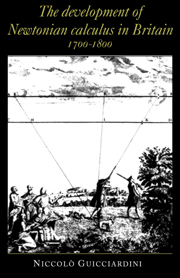Book contents
- Frontmatter
- Contents
- Introduction
- OVERTURE: NEWTON'S PUBLISHED WORK ON THE CALCULUS OF FLUXIONS
- PART I THE EARLY PERIOD
- PART II THE MIDDLE PERIOD
- 4 THE TEXTBOOKS ON FLUXIONS (1736–58)
- 5 SOME APPLICATIONS OF THE CALCULUS (1740–3)
- 6 THE ANALYTIC ART (1755–85)
- PART III THE REFORM
- CONCLUSION
- APPENDIX A TABLES OF CONTENTS OF FLUXIONARY TEXTBOOKS
- APPENDIX B PRICE LIST OF MATHEMATICAL BOOKS PRINTED FOR JOHN NOURSE
- APPENDIX C CHAIRS IN THE UNIVERSITIES
- APPENDIX D MILITARY ACADEMIES
- APPENDIX E SUBJECT INDEX OF PRIMARY LITERATURE
- APPENDIX F MANUSCRIPT SOURCES
- Notes
- Bibliography
- Index
5 - SOME APPLICATIONS OF THE CALCULUS (1740–3)
from PART II - THE MIDDLE PERIOD
Published online by Cambridge University Press: 14 September 2009
- Frontmatter
- Contents
- Introduction
- OVERTURE: NEWTON'S PUBLISHED WORK ON THE CALCULUS OF FLUXIONS
- PART I THE EARLY PERIOD
- PART II THE MIDDLE PERIOD
- 4 THE TEXTBOOKS ON FLUXIONS (1736–58)
- 5 SOME APPLICATIONS OF THE CALCULUS (1740–3)
- 6 THE ANALYTIC ART (1755–85)
- PART III THE REFORM
- CONCLUSION
- APPENDIX A TABLES OF CONTENTS OF FLUXIONARY TEXTBOOKS
- APPENDIX B PRICE LIST OF MATHEMATICAL BOOKS PRINTED FOR JOHN NOURSE
- APPENDIX C CHAIRS IN THE UNIVERSITIES
- APPENDIX D MILITARY ACADEMIES
- APPENDIX E SUBJECT INDEX OF PRIMARY LITERATURE
- APPENDIX F MANUSCRIPT SOURCES
- Notes
- Bibliography
- Index
Summary
the period which followed the death of Newton did not witness only the disputes about foundations: with Maclaurin's Treatise of Fluxions (1742) and Thomas Simpson's Mathematical Dissertations (1743) and Miscellaneous Tracts (1757) we find the best examples of successful applications of the calculus of fluxions. As was typical in the eighteenth century, Maclaurin's and Simpson's mathematical works were motivated to a great extent by mechanics and physical astronomy. The Principia constituted a field of research rich in problems which demanded improvements in mechanical concepts as well as in mathematical techniques.
Basically, all the natural philosophers who decided to accept the idea of universal gravitation had to cope with three great problems: the mathematical treatment of fluids, the determination of the shape of the Earth (and the motion of the tides), and the determination of the Moon's orbit and the perturbations of the planetary motions. What lay behind these problems was the necessity of extending mechanics from the study of point masses to continuous bodies. Both the study of the Earth, conceived as a rotating fluid, and that of the Moon were connected with the development of the mechanics of rigid and fluid bodies. In order to develop this programme in mechanics and astronomy, eighteenth-century mathematicians were compelled to reshape the calculus. New concepts, such as the concept of a function of many variables, and new theories, such as the theory of partial differential equations and the calculus of variations, were created in this context.
- Type
- Chapter
- Information
- Publisher: Cambridge University PressPrint publication year: 1989



